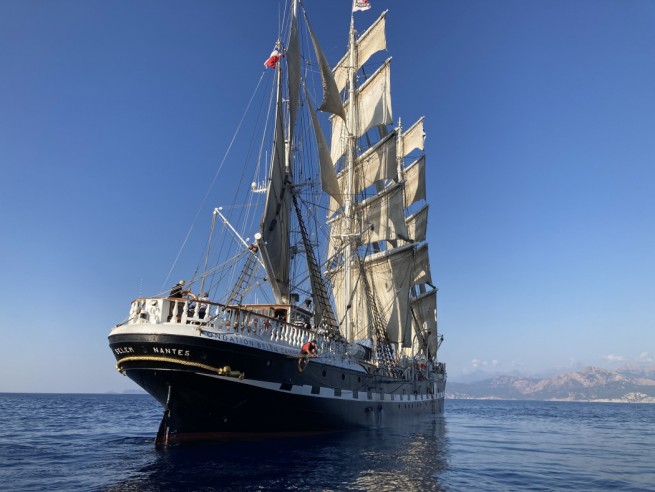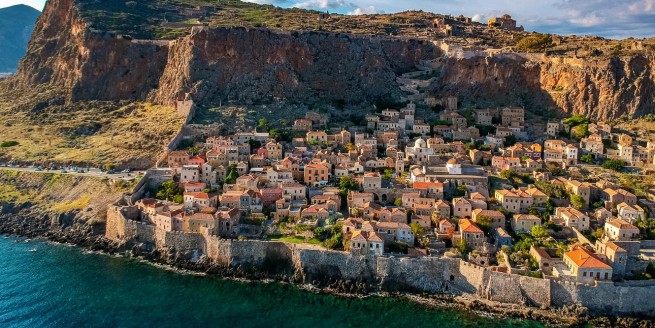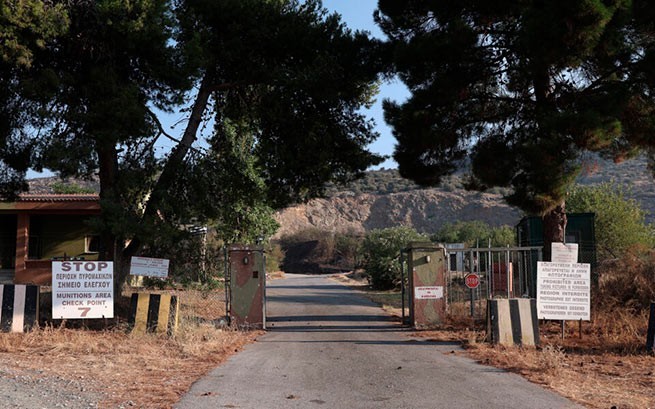Entrance to the armory of 111 IAP in Nea Anchialos
The “mushrooms” from the explosion of aerial bombs stored in an open area of an ammunition depot, located about 7 km north of the 111th Fighter Wing of the Hellenic Air Force at Nea Anchialos, brought to the surface a broader question and discussion of yesteryear.
https://rua.gr/news/procrim/56717-vzryvy-na-sklade-boepripasov-v-nea-agialo-video.html
Are the billions spent on the purchase of the latest weapons systems supported by the appropriate infrastructure? This issue has many implications, as the broader category of infrastructure includes those facilities that must exist to support weapons systems more cheaply and quickly.
On the day you buy a weapon system, there are always three categories of questions: who will operate it, how easy will it be to maintain, and, of course, what kind of infrastructure will be put in place to support it?
In the past four years, after a long period of lack of funding, failure and obsolescence of important types of weapons of all branches of the armed forces – the ground forces (F), Navy (Navy) and the Air Force, under the pressure of active Turkish revisionism, as well as NATO partners, decisions were made to purchase major and minor parts and systems (fighters, frigates, support vehicles, missiles and anti-UAV systems, etc.) with a total cost of about 14 billion euros. It is quite logical that the purchase of new weapons systems, in some cases technologically advanced by one or two generations compared to the arsenal that the armed forces are accustomed to having, creates a great need for their support and training.
https://rua.gr/news/sobmn/56839-sklad-111-iap-vzryvy-byli-vyzvany-bombami-kotorye-khranilis-v-improvizirovannom-khranilishche.html
Safety regulations
But what does this mean in practice? First, if we talk about the problem that arose with the ammunition depot at 111 am, it is quite obvious that the fire safety rules are outdated. Both in terms of the perimeter and location of the warehouses (there is a winery with flammable materials 300 meters away), and in terms of ammunition storage rules. According to the MoD, the ammunition was stored outdoors as allowed by the manufacturer (“outside storage”), however, as the result shows, this rule is not particularly suitable for Greece.
An even more serious problem is the lack of adequate means of prevention and fire fighting (automated and non-automated) in units of the greatest strategic and operational importance, such as 111 IAP. Recall that about 70 F-16 aircraft out of a total of 153 in the Air Force are based there. In addition, 111 IAP has facilities that can be used not only for maintenance, but also for the modernization of fighters. It is no coincidence that the upcoming modernization of 38 F-16 Block 50 will take place in Nea Anchialos.
https://rua.gr/news/sobmn/45977-gretsiya-ssha-tsena-nezhnoj-druzhby.html
Since developing air power is usually the largest investment, the infrastructure required each time the PA integrates new fighters is a management headache. This was exactly the headache that the PA employees had when deliveries of the first Rafale began. They have the same headache today, in connection with the future acquisition of the F-35. In the case of the Rafale, the solution was found from scratch, with additions and adaptations of the old 114 IAP shelters in Tanagra, the vast majority of which were built in the 1970s and 1980s. Employees are aware that the 24 Rafale aircraft that will be deployed at 114 IAP will not be able to stay in such premises for long, so steps are already being taken to strengthen and modernize them. If these solutions are adequate for the Rafale, then they are completely inadequate for the potential deployment of the F-35. The hangars currently in place at PA airports are in general inadequate to accommodate fifth generation aircraft. For this reason, the discussion of the issue of creating an appropriate infrastructure has already begun, and with such intensity that it even spilled over into the public sphere. The Air Force, however, is perhaps the only branch of the military that continues to be attractive to young people, thus providing a constant influx of manpower. As recent national examinations have shown, the number of guards entering the school is still over 18 and is of interest to many. In terms of training, the establishment of a new aviation center in Kalamata and the purchase of new jet trainers to replace the almost 50-year-old T-2s is also a step forward.
https://rua.gr/news/gospol/25843-frantsiya-prodala-gretsii-2-sovremennykh-fregata.html
The challenges facing the Navy are even greater as three frigates are currently under construction at Lorian, France, which will enable the country’s navy to transition into the digital age. Bringing three Cimon-class ships into the fleet, as the Supreme Naval Council (Navy) has dubbed modern French FDI, requires intervention at two levels: firstly, the training of personnel who can make the transition from the analog environment of existing in the frigate fleet (technologies of the 70s and 80s), and secondly, the creation of support crews for this type of ships. Greek-French cooperation is close enough to achieve this goal at the level of support. However, the big problem of the Navy at this stage is “bleeding” at the level of personnel. According to reliable sources, several officers and non-commissioned officers have retired over the past two years, representing up to 10% of the Navy’s personnel. Experienced observers note, however, that all developed countries of the world face this problem. In short, there are not so many who want to serve on the ship.
https://rua.gr/news/gospol/46347-ssha-predlozhili-gretsii-20-istrebitelej-f-35-za-usd3-5-mlrd.html
The Navy also faces the risk of fleet fragmentation in the future, and thus the risk of increased operating costs. The operating budget of the Navy is in any case extremely limited for the needs it has to meet. The necessary and urgent transfer of part of the fleet to the naval base of Souda, in order to be closer to the Eastern Mediterranean, has been worrying the leadership of the armed forces for many years, since part of the infrastructure of the Salamis naval base will have to be moved to Crete.
Systems support
The last and perhaps the most serious problem for the military as a whole concerns systems support. In recent years, the inefficiency of a once powerful defense industry, of which the Greek aviation industry (EAV) is a prime example, has led to systems becoming obsolete. The example of a fleet of transport aircraft, C-130s and C-27s, is perhaps the most revealing in terms of the inability of the domestic industry to meet the needs of the PA. Even negotiations with the United States in recent months on the purchase of new S-130s are a guarantee of the absence of a reliable naval air force. It is recalled that the EAB even undertook to deliver 74 more F-16 Viper aircraft by 2027 out of a total of 84 aircraft of this type. Just a few days ago, the tenth aircraft was delivered.
https://rua.gr/news/sobmn/33011-chto-prinesjot-gretsii-novoe-oboronnoe-soglashenie-s-ssha.html
In the field of the defense industry, the situation of Hellenic Defense Systems (HDS), which has factories in five different locations, is also of obvious importance. Although EAS was recently visited by Commissioner for Internal Market Thierry Breton, as part of the efforts EU to increase the capacity of defense production, since the ammunition depots of the member countries have become empty, thanks to the support of Ukraine, the company is still far from becoming competitive even at the local level.
What happened in the 111th Fighter Wing of the Hellenic Air Force
The results of the administrative investigation (IIN) of the causes of the spread of fire in the ammunition depot of the 111th IAP did not lead to conclusions that would be new. First, it confirmed the initial assessment that the wind was driving the fire at speed towards the ammunition depot, where a high heat load had developed. The situation led the fire and PA forces stationed there to order an evacuation. According to AN, the evacuation order was given only 8 minutes before the first explosion, so that practically the defense forces did not leave the facility until the last minute. Official leaks from the Department of National Defense of the conclusion state: “It was found that the sloping and hard-to-reach northern part, from where the fire reached and approached the area of open and closed warehouses, was incompletely cleared of garbage.”
https://rua.gr/news/procrim/56731-nea-ankhialos-iz-za-pozhara-unichtozhen-krupnyj-sklad-vooruzhenij-vvs-gretsii.html
It also found that the fire break around the warehouses “was insufficient” to prevent high-explosive bombs from detonating in the northern part of the warehouses. As stated in the conclusion – and as recently detailed – “The beds in question met international standards and contained only general purpose bombs, as required by the manufacturer’s manuals and specifications.”
More on the topic:
https://rua.gr/news/sobmn/56839-sklad-111-iap-vzryvy-byli-vyzvany-bombami-kotorye-khranilis-v-improvizirovannom-khranilishche.html
https://rua.gr/news/sobmn/56744-bespokojstvo-po-povodu-zapasov-oruzhiya-111iap-kakova-sudba-vooruzhenij.html
https://rua.gr/news/sobmn/56839-sklad-111-iap-vzryvy-byli-vyzvany-bombami-kotorye-khranilis-v-improvizirovannom-khranilishche.html
When will the new ships and aircraft be delivered?
Air Force
- 84 F-16 Vipers – 10 already delivered. Another 74 should be delivered by 2027.
- 24 Rafale – 17 already delivered. Another one will be delivered before the end of this year. The last six aircraft from the second order will begin deliveries to the PA in 2024.
- 20+20 F-35 – delivery schedule has not yet been determined, since a letter of acceptance (LOA) from the American side should precede Greece’s interest. If the letter arrives in Athens before the end of the year, then the appearance of the first fifth-generation fighter in 2028 is quite realistic.
Navy
The first French-built Κίμων-class FDI-class frigate is due to be handed over to the Navy in the first half of 2025, although the pace of work is encouraging that this could happen towards the end of 2024. The second frigate “Νέαρχος” will be delivered by the end of 2025, and the third one (“Φορμίων”) – in 2026. In between, the Navy will have to start withdrawing some of the 4 old MEKO frigates for modernization. Although new data will be added to the equation if the new corvette building program continues.
Based on the publication cathimerini.







More Stories
Greece will not give Ukraine either S-300 or Patriot (video interview)
MP beat up his colleague in the Greek Parliament
EU Commission warns Greece and Cyprus against fraud